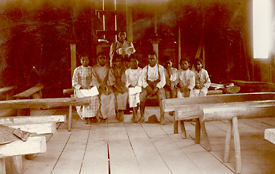The way history and myth come together over the 1863 Emancipation Proclamation is at the heart of an exhibit presented through Feb. 18 in the Hatcher Graduate Library.
“Proclaiming Emancipation” commemorates the 150th anniversary of Lincoln’s proclamation, issued Jan. 1, 1863. It marks a unique collaboration among the Law School’s Program in Race, Law & History, the William L. Clements Library and the U-M Library.
How Americans of the time reacted is shown in newspapers and broadsides of the day along with private letters and drawings. Martha S. Jones, associate professor of history, co-director of the Program in Race, Law & History and co-curator of the exhibit, says it embraces issues familiar to modern audiences — such as emerging media and the power of presidents.
Jones and co-curator Clayton Lewis, Clements Library, say that by the time of the proclamation, new technology allowed for the mass printing and distribution of national illustrated magazines and broadsides. They spread powerful images tied to emancipation, such as the slave breaking chains, or freed slaves shedding farmhand work attire for the tidy uniform of a proud Union soldier.
Abolitionist Fredrick Douglass also recognized the power of image, as he was careful to present himself well in photographs. “Douglass more so than nearly any American, save Lincoln, was keenly aware that photography was a medium that would change the nation’s political culture,” Jones says. “He was very careful about the reproduction of his own image, believing that his causes including antislavery and civil rights would turn in part on how figures like him were represented.”
The exhibit presents a rare early photograph of the former slave, who became known worldwide.

This post-Civil War photo of a class, likely in Virginia, depicts African-American students and their teacher. The unidentified photographer was believed to be a war veteran who returned to photograph battlefield sites, overgrown earthworks, empty fields and Arlington Cemetery. Photo courtesy William L. Clements Library.
“The proclamation also represents a critical turn in ideas about the power of the presidents, especially in war time,” Jones says. Lincoln used his authority as commander in chief to issue the proclamation, just as he had earlier in the war to suspend the writ of habeas corpus, she says.
Many believed Lincoln had overstepped. But today, questions about a president exercising power to act unilaterally and without the consent of the Congress, particularly in times of war, continue. “The origins of that debate are in the Emancipation Proclamation,” Jones says.
Lewis says that while the effect of the proclamation was huge,
the process of emancipation was already rolling through the
Underground Railroad before the war, and during the war as escaped
slaves migrated toward Union armies. “Certainly the proclamation
accelerated this process. It also pushed the North towards coming to
grips with emancipation as something more than an abstraction,” he says.
Once the proclamation was issued, abstraction became reality. “Thousands upon thousands of former slaves were displaced into the war, into the care of a Union army that is no way equipped to manage so many refugees,” Jones says.
While historians agree the proclamation is part of a series of historical events promoting equal rights for African Americans, the document’s myth as the vehicle for freeing the slaves follows it today.
“When the proclamation is displayed, once a year for 36 hours, thousands upon thousands of people show up to walk past the original document. That is the power of a sacred document and of myth,” Jones says. “It stands for our capacity as a nation to grow, to change, to evolve, to respond to injustice and inhumanity.”
More personal images from the exhibit include excerpts from private letters and Civil War soldiers’ sketchbook drawings. The soldiers drew escaped slaves, women washing clothes, and black soldiers. The drawings serve as interpretations of how they saw the process of emancipation in the field.
The exhibit is presented in the Hatcher Library’s Room 100 Gallery and Audubon Room.

